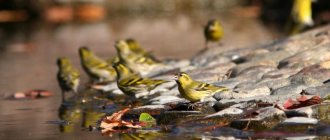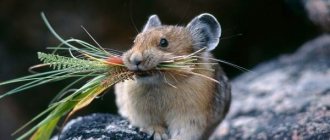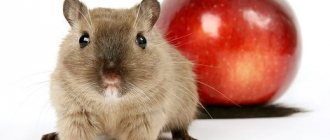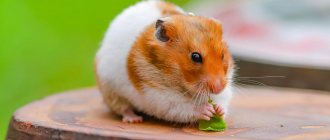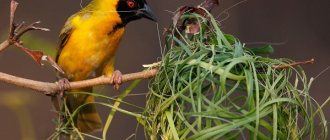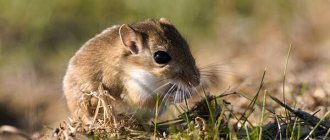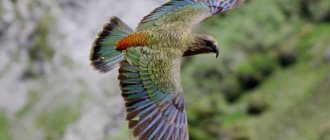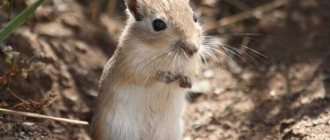- Wild animals
- >>
- Mammals
Gerbils are a large subfamily from the Old World. Its members are among the most distinct in the large rodent superfamily Muroidea, which includes mice, rats, voles, hamsters, gerbils and many other relatives. Members of the gerbil subfamily (Gerbillinae) have much in common. Most of them are diurnal, desert rodents. Gerbils are funny rodents that live in the wild and adapt well to home conditions. How and where gerbils live, everything about their methods of reproduction and other facts about their existence can be learned from this material.
Origin of the species and description
Photo: Gerbil
There are up to 110 species of gerbils in 16 existing genera. They belong to the mouse-like family and form a common branch with mice with long tails. They can be separated morphologically from other mouse-like species by a number of derived features. Molecular genetic studies of several mitochondrial and nuclear DNA genes confirm their independent origin and show that they are more closely related to mice and are the sister group of Deominaceae.
Video: Gerbil
In earlier classifications, Old World gerbils were often classified as the closest relatives of the Hamster or Madagascar rats and other endemic African mice. The close connection with the ancient mouse-like animals, which have a more complex type of molar tooth, was due to the great similarity in the pattern of molar crowns in gerbils and in them. However, most ancient mouse fossils have additional cusps of lower jaw teeth that were originally unknown in gerbils.
Modern gerbils have large eyes and good vision. They use auditory, chemical and tactile signals to perceive their environment. Rodents also exchange chemicals with each other, using pheromones to indicate reproductive and social status. Male gerbils communicate territorial ownership by marking territory with scent from their large ventral sebaceous glands. Gerbils do not live longer than three or four months in the wild. It is known that in captivity some individuals managed to live up to eight years.
How to choose an animal when buying
Buying a gerbil is fairly easy, provided you know what you're looking for and what to avoid. Before purchasing, you must be absolutely sure of their gender. If you accidentally bring home a male and a female, you will be forced to look for a home for several dozen new individuals every year.
To find out the gender, analyze the place under the animal's tail - to do this, gently turn it onto its back . The main difference is that the genital opening and anus in females are much closer to each other than in males. The second difference is that females' genitals are usually not as raised as those of males. The latter also have a large protrusion under the tail due to the fact that the testicles are located under the skin rather than outside.
Did you know? Young gerbils often fight each other. This is not a fight, but a means of teaching young animals self-defense skills in the desert.
Avoid purchasing from online stores, because you will not be able to see the pet before purchasing and will not be sure that you will actually receive the animal you ordered.
When choosing, make sure that the gerbil:
- clean clear eyes;
- neat fur without bald spots;
- there is no discharge from the holes or scabs on the skin.
If an animal looks too thin or too fat, then it probably has health problems . To understand this, look at photos of healthy gerbils before you go to the store. An uneven gait is also a manifestation of skeletal or muscle diseases.
Inspect the cage in which the animal is kept in the store. Dirty, unkempt, unsanitary or overcrowded is highly likely to be a source of parasites and infections. Buy animals only where the conditions for keeping them are acceptable.
Also pay attention to temperament . Despite the fact that these are just cute mice, they can be capricious, so do not take fighters or animals sitting quietly in the corner. A healthy mouse is always active, but not aggressive.
We recommend reading how to choose a name for a girl chinchilla.
Appearance and features
Photo: What a gerbil looks like
Gerbils are small to medium-sized rodents. Their length ranges from 50 to 200 mm, and their tails range from 56 to 245 mm. The weight of individuals is from 10 to 227 grams. Even within a species, males may be heavier than females in one population and may be the same size in another population. These are usually slender animals with long claws. They may have long or short ears. Most gerbils have long, well-furred coats and long, narrow hind legs.
The fur color varies over a wide range of colors and can be reddish, grey, yellowish, clayey, olive, dark brown, orange-brown, sandy yellow or pinkish-cinnamon on the dorsal surface. The underparts are usually lighter shades of grey, cream or white. Some species have whitish spots on the head, especially behind the ears.
Gerbils have a dental formula of 1/1, 0/0, 0/0, 3/3 = 16, with the exception of the genus Desmodilliscus, which has only two lower molars on each side. The layers of enamel on the incisors are very thin compared to other rodents. Gerbils have 12 thoracic and seven lumbar vertebrae. Females have three or four pairs of mammary glands. The stomach consists of only one chamber. Gerbils are related to mice and rats and belong to the family Muridae.
Where does the gerbil live?
Photo: Gerbil in Russia
Gerbils are Old World rodents. They are distributed throughout Africa and the Middle East, through Central Asia including most of India, China (excluding the southern and eastern regions) and eastern Mongolia. Their range extends from several islands in the eastern Mediterranean and northeastern Ciscaucasia to Transbaikalia and Kazakhstan.
The gerbil's range is concentrated in three main regions:
- in the savannas of Africa, as well as in the Namib and Kalahari, where winter temperatures often drop below zero;
- in hot deserts and semi-deserts of Africa and the Middle East, as well as in the dry Horn of Africa;
- in the deserts, semi-deserts and steppes of Asia, where winter temperatures also drop significantly below zero.
Individual genera usually belong to one of these three regions. Most gerbils live in dry, open habitats with sparse vegetation, including deserts, sand plains, mountain slopes, grasslands, steppes and savannas. Some species also live in moist forests, agricultural fields and mountain valleys.
Water is usually excreted through the skin, breath, urine and feces. Most gerbils live in arid regions with difficult climatic conditions and have a body surface that is unfavorably large in relation to volume. They have developed tailored properties to minimize water loss and thereby reduce fluid requirements. They do not sweat and therefore cannot withstand temperatures above 45 °C for more than two hours.
Now you know where the gerbil lives. Let's see what she eats.
What does a gerbil eat?
Photo: Gerbil mouse
Gerbils primarily feed on plant material such as seeds, fruits, leaves, stems, roots and tubers. Nocturnal species of true gerbils search for wind-blown seeds in the desert. The Indian gerbil is the only species that needs fresh food all year round, so it often lives near irrigated fields. However, most species take what they can get and also eat insects, snails, reptiles and even other rodents. In particular, animals in the extremely dry deserts of southern Africa primarily catch insects, and the Wagner's gerbil (G. dasyurus) produces mountains of empty snail shells.
The gerbil's favorite treats include:
- nuts;
- seeds;
- roots;
- bulbs;
- fruit;
- herbs;
- insects;
- bird eggs;
- chicks
- reptiles;
- other rodents.
The food is usually eaten immediately as a precaution. Species in areas with cold winters store large reserves during construction; they store it at a depth of up to 1 meter. Their burrows store a large amount of plant food - sometimes up to 60 kg. Gerbils are primary and secondary consumers, as well as food for a number of higher-level consumers. They pollinate some plants and probably play a role in seed dispersal.
History of the origin and domestication of the gerbil
Most domestic gerbils are Mongolian gerbils . According to legend, their first breeder and owner was Genghis Khan. He gave the animal the name “clawed warrior” because the gerbil bit the leg of an assassin who made his way to the khan dozing in the tent. The awakened Genghis Khan grabbed his sword and struck the enemy. Subsequently, he took the small rodent with him everywhere.
The first known images of the animal date back to the 19th century. It was described and classified by the French missionary, traveler and zoologist Father Armand David.
Important! Although gerbils
-
desert animals, in the heat they can overheat.
For this reason, they need constant access to water, as well as a cage that is not in direct sunlight. The animals described did not immediately become popular in citizens’ homes. Only in the late 1960s was the first international exhibition of these cute rodents held, after which their active popularization began. Gerbils are unpretentious, very active, friendly, perfectly adapt to life in captivity and have no smell . All of these qualities make these mice attractive and popular small pets.
Features of character and lifestyle
Photo: Mongolian gerbil
Gerbils are underground dwellers. Some species are capable of jumping up to 3.5 meters. Other species run exclusively on all fours. Those who live in rocky areas are often good climbers. For the most part, gerbils are diurnal rodents, but some species are nocturnal, crepuscular, or 24-hour.
Fun Fact: Gerbils build burrows with a single entrance and nesting chamber, or complex networks of tunnels with multiple entrances and chambers for nesting, food and excrement storage. Gerbils take dust baths to keep their silky fur in good condition.
Some species of gerbils are solitary animals, aggressive and territorial, each living in its own burrow. Other species are highly social and form large colonies, with many individuals inhabiting tunnel networks tens of meters long and two or three meters deep. Still others live in small family groups, with each family group defending its own territory. There is a lot of socializing among some gerbils while they are in the nest. The cubs groom, chase, and play and fight when they are between 18 and 35 days old.
Gerbils are largely confined to the same territory, although young individuals may go through a nomadic period in their lives until they are able to establish a permanent home range, and some species migrate during times of drought. They do not hibernate during the winter, but in some areas they experience prolonged bouts of torpor during the winter and remain in their burrows, feeding on stored food for several months.
Breeds of gerbils and their characteristics
There are many different types of gerbils—more than 100— but only a few are commonly kept as pets:
- Mongolian;
- short-eared;
- bushy-tailed;
- fat-tailed
They look very different and have different lifespans. Mongolians will live 2 to 4 years, while fattails often live 5 to 8 years. Below is information about these species. Please note that all but the Mongolian are quite rare in the pet market and much harder to find in pet stores.
We recommend reading how to choose names for mice: for girls and boys.
Short-eared
Classification:
- family: Mouse (Muridae);
- subfamily: gerbils (Gerbillinae);
- species: short-eared gerbil (Desmodillus auricularis).
This is a mouse with short ears. Widely distributed in the deserts of Angola, Botswana, Namibia and South Africa. It is nocturnal and hides in deep burrows during the day. It feeds on grass seeds and insects.
Characteristic:
- adult weight: 0.055 kg;
- body length: 90–125 mm;
- tail length: 81–100 mm;
- ear length: 11 mm;
- maximum life expectancy: 6 years;
- pregnancy: 29 days;
- number of cubs: 1–7;
- birth weight: 0.003 kg;
- the cubs are independent from 33 days;
- body temperature: 35.85°C.
Mongolian
The Mongolian gerbil, or clawed gerbil (Meriones unguiculatus), has become popular since the middle of the last century. These animals attract with their cute, friendly temperament.
Did you know? Mongolian gerbils can spend hours constructing complex tunnels for their family.
In their natural environment, they live in families in the deserts of East Asia, including Mongolia, Kazakhstan, Kyrgyzstan, Tajikistan, Turkmenistan, Uzbekistan, and also in China. In some areas they are considered rare due to trampling of the area by large animals, such as camels.
They dig long holes to avoid predators . They feed on seeds and vegetation. Able to survive in conditions of both heat and cold. The length of the mouse is 20 cm, and the weight is 70–120 g. The pubescent tail ends with a tassel. Today there are a number of colors obtained through genetic modifications of individuals of this species. Among them are golden, black, dove, silver, cream, and ivory.
Fluffy-tailed
The fluffy-tailed gerbil (Sekeetamys calurus) lives in rocky areas and mountains in Egypt, Israel, Jordan, Saudi Arabia and Sudan. It differs from other species by its thick fluffy tail.
Features of the animal:
- adult weight: 0.065 kg;
- body length: 10–12 cm;
- tail length: 11–16 cm;
- fur: yellow to reddish;
- the tail ends with a white tassel;
- maximum life expectancy: 7 years;
- number of cubs in the litter: 3;
- body temperature: 37.85°C.
Social structure and reproduction
Photo: Pair of gerbils
During mating, copulatory plugs are formed in the reproductive tract of females, which prevent subsequent matings. Some species of gerbils breed year-round, while others breed seasonally. Females of most species are capable of producing several litters per year. Some also experience postpartum heats and delayed implantation, so that a new litter begins to develop as soon as the first one is weaned. Gestation periods, if the female does not breastfeed, last three to four weeks.
Litter sizes range from 1 to 13, although litters of 4 to 7 are much more common. Young gerbils are born completely naked and blind. Fur begins to grow between 8 and 13 days after birth, and they are completely covered in fur after 13-16 days. The eyes open approximately two or three weeks after birth. The young can walk and jump quickly after about three weeks. At the age of one month, the cubs are weaned and become independent. They reach maturity in 10-16 weeks.
Fun Fact: Mothers care for their babies by licking the newborn's hindquarters to encourage them to produce urine and feces, which they then consume.
Female gerbils care for their young until they are about 30 days old. Gerbil mothers are known to move their young to new nests several times in the first few days after birth, as well as change burrows between litters. When they leave young in the nest to go out to feed, they sometimes cover their brood with grass and sand and block the entrance to the nest. Females carry their young by clutching them in their mouths.
As soon as the young individuals begin to move around a lot, the mothers grab them by the tails and pull them towards them, and then take them back to the nest. They stop picking up their children when they are between 17 and 23 days old. Gerbil mothers care for their litters until they go out on their own. Males of some species care for their litters in the same way as females.
Natural enemies of gerbils
Photo: Gerbil
Gerbils do not have many predators in their natural habitat. They are mainly hunted by various snakes, owls and small mammals, all predators that exceed them in size. To discourage attackers from entering their burrows, some gerbils seal the entrances with sand. Others include escape passages in their burrow systems where they can hide if attacked in the open. In addition, gerbils have neutral-colored fur that serves as camouflage and helps them blend into sandy or rocky backgrounds.
Known predators that prey on gerbils include:
- snakes;
- owls;
- carnivorous mammals.
Gerbils are parasitized by several types of fleas, such as:
- xenopsylla cumulus;
- xenopsylla debilis;
- xenopsylla difficilis.
Some gerbils are considered pests in their native range because they destroy crops, damage embankments and irrigation systems, digging up and spreading bubonic plague. Therefore, they are destroyed by people in their natural habitat. There is also concern that domestic gerbils could escape and create wild populations that would crowd out native rodents.
Interesting fact: When attacked by a gerbil, it, like a lizard, is capable of throwing off its tail, but this rodent does not grow a new tail, like reptiles.
Gerbils, especially clawed shrews, are very clean animals that are easy to care for and breed easily in captivity. For these reasons, these rodents are used in many laboratories for medical, physiological and psychological research. They are also popular pets.
Diseases and their treatment
It's a good idea to find out where small rodent treatment services are available in your area before you need help. If you think your pet is not healthy, analyze the symptoms. A clear presentation of them will help the doctor determine the diagnosis.
Gerbils are in very good health and rarely get sick . But they can be affected by environmental factors that cause conditions that require the intervention of owners or a doctor.
Did you know? Gerbils can shed their tail when attacked by a predator. It does not grow back, but the site of tissue rupture quickly heals naturally.
Main problems:
- As a result of stress, the animal may experience body twitching, salivation and ear twitching . Remove the source of stress and create a calm environment. Over time, the behavior will return to normal.
- The animal scratches its nose - this may be an allergy to stale hay, the detergent used to clean the cage, or another irritant. Eliminate this source from the environment.
- Excessive production of tears is an inflammation of the eyes due to poor-quality bedding. You need to show your pet to a doctor so that he can determine whether the inflammation is a sign of infectious diseases and prescribe treatment based on the examination results.
- If your pet scratches its ears and there are dark particles in them that look like dirt, these are mites . Treat gerbil with Ivermectin.
- A cough is a sign of a cold. You need to show your pet to a doctor to prescribe a course of antibiotics. You cannot select them yourself, since to determine the dose you need to take into account the age and weight of the animal.
- Diarrhea is a serious sign of infection. The animal must be quarantined and immediately shown to a veterinarian.
Population and species status
Photo: What a gerbil looks like
Due to its underground lifestyle, it is difficult to determine the exact population size of this rodent. Several species of gerbils are threatened due to human interference in their habitat. Most animals live in sparsely populated areas, while others are considered pests in part because they destroy agricultural crops and cause serious damage to agricultural infrastructure. So farmers fight them by gassing them or plowing up their building systems.
As a host to fleas, the gerbil spreads diseases such as plague and is a carrier of the dangerous leishmaniasis. The highest rates of leishmaniasis infection occur in the fall. There were 5.8% of gerbils that were found infected only with L. major, and 23.1% with Leishmania turanica. Mixed natural infection was observed in rodents with L. major and L. turanica (21.2%). On the other hand, the sweetish meat of the gerbil is considered a delicacy in some areas. Many species are used by people as experimental animals in laboratories, while others have become beloved pets without which life would seem sadder.
Reasons for the popularity of gerbils as pets include:
- animals are not aggressive;
- rarely bite without provocation or stress;
- they are small and easy to handle;
- Very sociable creatures that enjoy the company of people and other gerbils.
Gerbils have adapted their kidneys to produce a minimal amount of waste to preserve body fluids, making them very clean and almost odorless. Several members of the genus of lesser gerbils live in the wild in Russia, including the midday gerbil (M. meridianus). There are a total of 110 species of gerbils, belonging to 14 genera.
Nutrition
The diet of a gerbil mouse includes: bread, legumes, hay and green grass. Among the tree species they like are willows, poplars and lindens. If we talk about grain food, then a favorite treat is sprouted or soaked cereal seeds in water. They will not refuse beets, carrots, berries and sunflowers.
The gerbil's menu at home can be varied with cottage cheese, boiled eggs, mealworms, and locust insects. Young animals are ready to try a wide variety of foods, even sausages. Don't forget about mineral supplements. At home, this can be chalk, eggshells or glycerophosphate.
Extreme living conditions have taught gerbils to be content with little. They don't need water. For the life of this mouse, moisture obtained from plants and fruits is sufficient. In their normal habitat, gerbils feed on vegetation that is within their reach. Like all rodents, they store food for the winter.
Their “storerooms” contain camel thorns and twigs of various desert plants. If food is scarce, gerbils emigrate to other areas. In search of food, they settle in new places or adapt other people's burrows for their own living.


